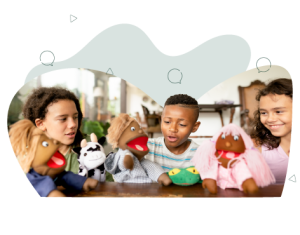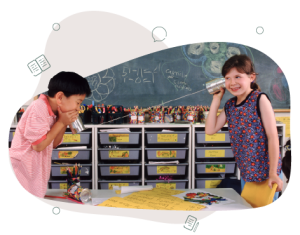14 Language and literacy
A strong relationship exists between play-based learning and the development of language and literacy (Han et al., 2010; Van Oers & Duijkers, 2013). For example, in pretend play and constructive play, students form imaginary stories that support the development of narrative skills, including story comprehension and story production. They will also develop the ability to symbolise and use an object as something else, which has been found to be a predictor of a student’s expressive and receptive language ability (Stagnitti et al., 2020).
In all types of play experiences, students engage in greater social and linguistic interaction to collaborate with peers. In particular, the development of narrative in pretend play supports:
- the emergence of early multi-word speech,
- more complex grammatical speech, and
- greater growth in linguistic knowledge, including vocabulary and grammar.
Research highlights the benefits of pretend play during the first years of school in comparison to learning through direct, didactic instruction (Fekonja et al., 2005; Stagnitti et al., 2016).

The teacher’s role in supporting capability building
Communication skills are an important part of children’s development and learning. There is ample evidence that points to the role of play based learning in cultivating language and literacy skills, particularly in the early years (Roskos & Christie, 2013; Sharp, Escalante, & Anderson, 2012). Building student literacy and language skills through play-based approaches is effective, whether it’s teacher-guided play or child-directed play that is supported by the teacher (Roskos, 2010; Weisberg et al., 2013; Zosh et al., 2017).
To support students’ exploration and application of literacy and language in play-based learning experiences, teachers can:
- Use meaningful and planned interactions to guide students towards emergent reading and writing skills. For example, understanding the function and form of print, the relationship between oral and written language, recognising words as discrete elements and showing an understanding of phonological structure (Justice & Pullen, 2003; Sliogeris & Almeida, 2017).
- Provide a literacy rich environment that prompts students to explore and engage with literacy knowledge. For example, students can be guided to write shopping lists, write signs, document their stories, record their planning, and report their findings. These artefacts can all be used as assessable documents of student learning.
- Encourage students to investigate a concept further through multimodal resources. For example, students may be constructing a story using loose parts, or other props. The students might record their narrative using an iPad and come back to it later to develop the story further. The recording captures the children’s voices, and the play that is inspiring the story.


